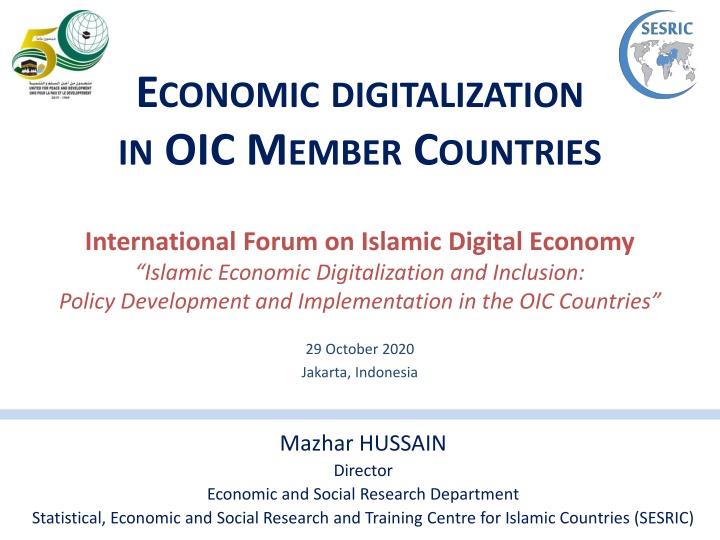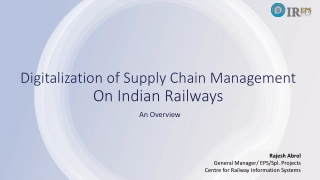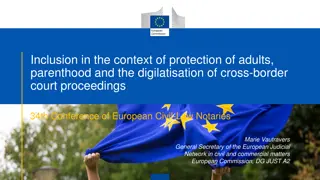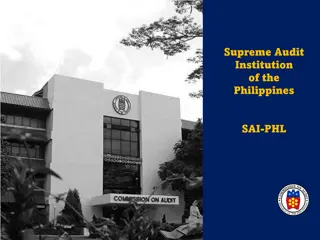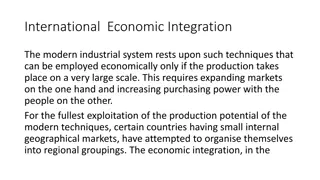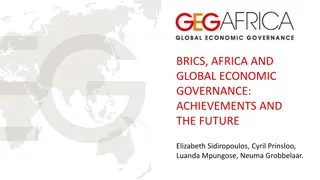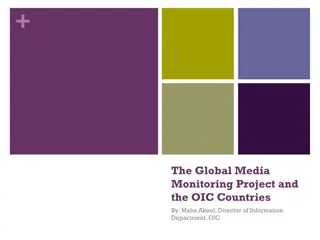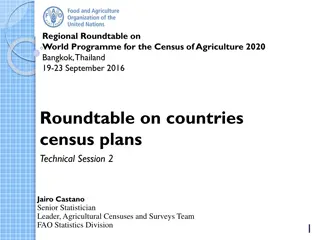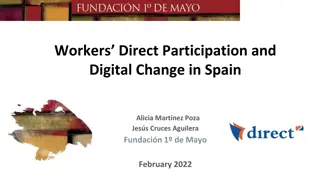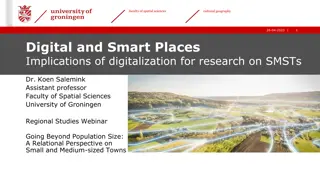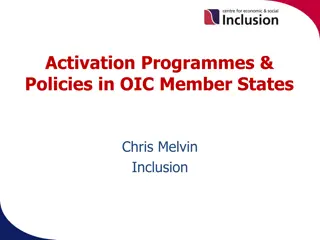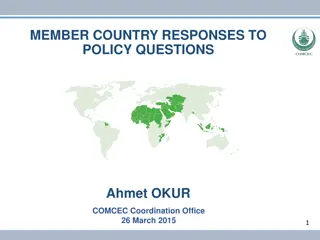Economic Digitalization in OIC Member Countries: Opportunities and Challenges
Economic digitalization in OIC member countries is gaining momentum, with a focus on integrating digital technologies into everyday life and fostering the digital economy. This shift presents both prospects and challenges, requiring a comprehensive strategy for policy development and implementation. The evolution of global internet traffic, the impact of digitization and digitalization on e-life, and measuring the digital economy are key areas of discussion, highlighting the need for reliable statistics and tools to assess the level of transformation. Moving forward, enhancing ICT infrastructure, promoting ICT usage, and building capabilities for effective ICT utilization will be crucial for leveraging the benefits of digitalization in the Islamic world.
Download Presentation

Please find below an Image/Link to download the presentation.
The content on the website is provided AS IS for your information and personal use only. It may not be sold, licensed, or shared on other websites without obtaining consent from the author.If you encounter any issues during the download, it is possible that the publisher has removed the file from their server.
You are allowed to download the files provided on this website for personal or commercial use, subject to the condition that they are used lawfully. All files are the property of their respective owners.
The content on the website is provided AS IS for your information and personal use only. It may not be sold, licensed, or shared on other websites without obtaining consent from the author.
E N D
Presentation Transcript
ECONOMIC DIGITALIZATION IN OIC MEMBER COUNTRIES International Forum on Islamic Digital Economy Islamic Economic Digitalization and Inclusion: Policy Development and Implementation in the OIC Countries 29 October 2020 Jakarta, Indonesia Mazhar HUSSAIN Director Economic and Social Research Department Statistical, Economic and Social Research and Training Centre for Islamic Countries (SESRIC)
Outline 1. Digitalization 2 2. Digital Economy 3 3. Prospects and Challenges 4. Way Forward 2
Digitization, Digitalization Towards E-life Digitization is the process of converting information into a digital (computer-readable) format. Digitalization is the integration of digital technologies into everyday life. Developments in Information & Communication Technologies (ICT) E-mail E-commerce E-trade E-government E-banking E-learning E-gazette Social Media Artificial Intelligence Database Virtual Reality Cloud Computing Internet Online Robotics Data CAD Mobile Devices 3G 4G 5G Blockchain Big Data PDF Automation Cybersecurity Bluetooth Infrastructure Computers Internet of Things Broadband Link 3
Evolution of Global Internet Traffic The internet and connected devices have become a central part of most individuals and firms everyday life across the world. |2022| ! + + By 2022, global IP traffic is projected to exceed 150 thousand GB per second 150,700 GB per second More and more people coming online for the first time Increase in mobile and fixed broadband subscriptions | 2017| + Expansion of the Internet of Things (IoT) 46,000 GB per second | 2007| 2,000 GB per second | 2002| 100 GB per second 4 UNCTAD (2019)
Measuring Digital Economy Digital transformation today affects all spheres of life. However, defining the digital economy is not a straightforward task. Measuring the digital economy and related value creation and capture is fraught with difficulties. Firstly, there is no widely accepted definition of the digital economy. Secondly, reliable statistics on its key components and dimensions, especially in developing countries, are lacking. (UNCTAD, 2019) There is currently no internationally agreed definition of the Digital Economy overall, and this has been identified as one important barrier to meaningful and comparable measurement. (OECD, 2020) Comprehensive tools are needed to assess the level of transformation into the digital economy and the factors affecting it. A combination of three factors is key to the data-driven digital economy; Availability of ICT infrastructure and access, High level of ICT usage, and Capability to use ICTs effectively 5
Definition of Digital Economy The Digital Economy incorporates all economic activities reliant on, or significantly enhanced by the use of digital inputs, including digital technologies, digital infrastructure, digital services and data. It refers to all producers and consumers, including government, that are utilizing these digital inputs in their economic activities. (OECD, 2020) DIGITALIZATION Conversion of information into digital form Economic activities using digital inputs Application of digital technologies DIGITAL ECONOMY DIGITIZATION 6
Size of Global Digital Economy | DIGITAL ECONOMY | 4.5-15.5% of World GDP |USA & China| 40% of World Total Value Added in ICT Sector | Global employment in the ICT sector | 39 million in 2015 34 million in 2010 | Digitally deliverable service exports, 2018 | $2.9 50% Trillion Global Services Exports | ICT sector in total employment | 2% in 2015 1.8% in 2010 8 Source: UNCTAD (2019)
Digital Economy in OIC Countries Muslims represent an important consumer base of around 2 billion people Data on Contribution of Information and Communication Technology (ICT) to the national economy doe not exist for the majority of OIC Countries! Available statistics on share of ICT in GDP show a great degree of variation among member countries. Malaysia (18.3%, 2018); Nigeria (13.9%, 2019); Morocco (5- 6%, 20..?); UAE (4.3%, 2017); Egypt (4%, 2018/19); Indonesia(3.76%, 20 ?);Qatar (2.7%, 2017) Share of ICT goods in total goods exports is another important indicator to gauge the economic importance of digitalization. Bahrain (0.4%); Benin (0.1%); Brunei (0.2%); Egypt (2.4%); Gambia (0.1%); Indonesia (2.9%); Jordan (2.0%); Malaysia (33.1%);United Arab Emirates (7.1%) Islamic Digital Economy Muslim consumers value to the global digital economy is estimated to be worth US$277 billion (DinarStandadrd) Most of it is e-commerce spending by the consumers Turkey, Malaysia, Egypt and Indonesia are the top countries w.r.t. Muslim digital commerce spending 9
Developments in ICT Sector-I 108.0 Mobile-cellular telephone subscriptions Individuals using the Internet 100 Fixed-telephone subscriptions 83.0 Active mobile-broadband subscriptions 80 Fixed-broadband subscriptions Per 100 inhabitants 60 53.6 40 20 14.9 12.1 0 2001 2003 2005 2007 2009 2011 2013 2015 2017 2019* Note: * Estimate Source: ITU World Telecommunication /ICT Indicators database 10
Developments in ICT Sector-II World 107 World 74 Developed Non-OIC 125 Developed Non-OIC 125 Mobile Cellular Telephone Subscriptions , 2019 (per 100 inhabitants) 105 100 107 103 111 Active Mobile broadband Subscriptions , 2019 (per 100 inhabitants) 71 OIC ECA OIC ECA 54 70 ESALA MENA SSA ESALA MENA SSA 60 70 83 29 0 50 100 150 0 50 100 150 87 65 63 51 Individuals Using the Internet, 2019 (per 100 inhabitants) 47 Comparatively LOW penetration of ICT in OIC group with substantial OIC sub-regional differences 41 31 28 11 Source: Calculations based on ITU Statistics
Developments in ICT Sector-III United Arab Emirates (2) 240 United Arab Emirates (3) 201 Active Mobile-broadband Subscriptions, 2019 Mobile Cellular Telephone Subscriptions, 2019 Kuwait (15) 132 Kuwait (11) 174 Brunei Darussalam (18) 128 Turkmenistan (17) 163 (per 100 inhabitants) Malaysia (19) 127 Maldives (20) 156 (per 100 inhabitants) Qatar (21) 125 C te d'Ivoire (28) 145 OIC 54 OIC 100 Syria (187) 12 Somalia (197) 49 Yemen (196) 6 Chad (198) 48 Niger (198) 4 Mozambique (200) 48 Chad (199) 3 Djibouti (206) 41 Somalia (201) 2 Niger (207) (World Ranking) 41 (World Ranking) Individuals Using the Internet, 2019 (per 100 inhabitants) Digital Divide Large differences among OIC countries 99.7 99.7 99.5 99.2 95.7 40.8 2.0 3.9 5.3 6.5 8.5 (World Ranking) 12 Source: Calculations based on ITU Statistics
Internet Users Internet Users, 2010 (Share in Total) | 2019 | Internet Users, 2019 (Share in Total) 3.94 billion active internet users 12% 19% 24% 38% 50% 57% 51.3% of the global population Developed Non-OIC Developing OIC More and more people in the developing world access to the internet over time. This process is somewhat faster in OIC countries than in the other developing countries. 13
Increase in Internet Users in OIC Countries | 2019 | Number of Internet Users (millions), 2010 vs. 2019 765 million active internet users in OIC Countries 129 2010 2019 Change 103 84 66 62 58 58 46 40 33 29 26 18 18 530 million newinternet users in 2010-2019 12 Indonesia Nigeria Iran Egypt Turkey From to Internet Users per 100 Inhabitants, 2010 vs. 2019 15 users in 2010 41 users in 2019 2010 2019 Change 95.7 92.4 81.9 70.0 56.6 55.7 54.7 54.1 50.3 49.2 Additional 26 users per 100 inhabitants 41.0 40.8 35.8 15.9 31.6 15.0 25.8 6.5 Oman Saudi Arabia Iran Kazakhstan Djibouti OIC 14
Mobile and Broadband Download Speed (Mbps) | September 2020 | 36 Mbps Global Average MobileDownload Speed Mobile Only 10 out of 39* OIC countries above the global average. Some member countries (Sudan, Palestine, Afghanistan) have a mobile download speed below 10 Mbps. South Korea 121 China 113 United Arab Emirates 109 Qatar 93 Netherlands 80 Norway 79 Saudi Arabia 76 Canada 76 Bulgaria 76 Australia 72 0 50 100 150 Only 4 out of 52* OIC countries above the global average (UAE, Kuwait, Malaysia, and Qatar). Half of OIC countries have download speed below 20 Mbps. In Turkmenistan, Yemen, and Algeria, the download speed is below 5 Mbps. Fixed Broadband | September 2020 | 86 Mbps Global Average Fixed Broadband Download Speed Singapore 227 Hong Kong 211 Romania 193 Switzerland 179 Thailand 175 France 173 Denmark 162 Monaco 162 Hungary 162 United States 161 15 0 50 100 150 200 250 Source: SpeedTest.net
Connectivity and Digitalization Global Connectivity Index - GCI (Huawei) created to analyze a broad spectrum of indicators for ICT Infrastructure and digital transformation to provide a comprehensive map of the global digital economy. 18 out of the 79 countries included in GCI are OIC members United Arab Emirates, Malaysia, Bahrain, Oman, and Saudi Arabia are top performers GCI Ranking of OIC Countries, 2015 vs 2019 2015 2019 78 78 77 76 75 75 74 73 80 71 68 65 64 64 63 63 70 62 61 59 58 57 60 49 47 46 46 45 43 43 50 42 40 34 33 40 32 30 28 23 30 22 20 10 0 Decline in Ranking Improvement in Ranking 16
National Initiatives to Develop Digital Economy Many OIC member countries have national strategies and plans of actions to develop their national digital economy. Nigeria (Nigeria Vision 2020); Gabon Egypt (ICT 2030 Strategy), Algeria (E-Algeria), Morocco (Digital Morocco 2020) , Tunisia, United Arab Emirates (Vision 2021), Bahrain (Vision 2030); Oman (Digital Oman Strategy , eOman); Jordan(Action Qatar (e-Government 2020 Strategy) Plan REACH2025); Malaysia; Indonesia 17
Regional Initiatives Digital Economy for Africa Initiative (DE4A) by World Bank Aims to ensure that every individual, business, and government in Africa will be digitally enabled by 2030 in support of the African Union Digital Transformation Strategy for Africa. To support this initiative, the World Bank intends to invest $25 billion by 2030. Asia-Pacific Regional Initiatives, Buenos Aires Action Plan, 2018-2021 by ITU ITU activities in Asia-Pacific are centred on regional initiatives designed to address specific priority areas of particular importance to the region. The World Telecommunication Development Conference in Buenos Aires (Argentina) in October 2017 adopted the following five regional initiatives (2018-2021) for Asia and the Pacific. 1. Addressing special needs of least developed countries, small island developing states, including Pacific island countries, and landlocked developing countries 2. Harnessing information and communication technologies to support the digital economy and an inclusive digital society 3. Fostering development of infrastructure to enhance digital connectivity 4. Enabling policy and regulatory environments 5. Contributing to a secure and resilient environment 18
Risks & Challenges Although digitalization has the potential to support development, the outcomes are not likely to benefit all stakeholders equally. Even if individuals, firms and countries do not or only partially take part in the digital economy, they can still be adversely affected indirectly. Workers with limited digital skills Local firms competing with digitalized domestic and foreign ones Various jobs lost due to automation Cyber security (cyber-attacks, viruses, and fraud) & privacy issues 19
Major Obstacles Limited awareness of e-commerce relevance among policymakers and lawmakers, consumers and businesses. Limited Internet access in rural/remote areas and costly access to fixed and mobile-broadband Internet. Overreliance on cash-based transactions, plus low access to and limited experience with online payments and the use of credit cards. Inadequate facilities for physical delivery of online purchases. Weak legal and regulatory frameworks, including protection of consumers online. Inappropriate education for the digital economy. Lack of business development skills and adequate e-commerce skills for MSMEs. Unsuitable financial mechanisms for start-up enterprises to engage in e- commerce. Persistent barriers for women and youth to engage in e-commerce, preventing the leveling of playing fields through increased inclusivity. Lack of statistical data on electronic commerce. 20 Source: UNCTAD (2019)
Focus Areas for Digital Future Innovation & Technology Adoption Empowering Society Infrastructure Jobs & Growth R&D in Information Industries Investment in Broadband Digital Literacy ICT Investments Focus on Mobile Broadband Narrowing the Digital Divide Supporting Business R&D Jobs in the ICT Industries Higher Internet Speed People s use of the Internet ICT Use by Businesses E-Commerce Prices for Connectivity Mobile Money Household Access to Computers & Internet E-Government 21 Source: Adopted from OECD (2018, 2020)
THANK YOU FOR YOUR ATTENTION www.sesric.org
